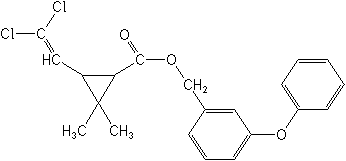-
Common NamePermethrin
-
中文通用名氯菊酯
-
IUPAC3-phenoxybenzyl (1RS,3RS;1RS,3SR)-3-(2,2-dichlorovinyl)-2,2-dimethylcyclopropanecarboxylate
or
3-phenoxybenzyl (1RS)-cis-trans-3-(2,2-dichlorovinyl)-2,2- dimethylcyclopropanecarboxylate -
CAS(3-phenoxyphenyl)methyl 3-(2,2-dichloroethenyl)-2,2-dimethylcyclopropanecarboxylate
-
CAS No.52645-53-1
-
Molecular FormulaC21H20Cl2O3
-
Molecular Structure
-
Category
-
ActivityPermethrin is a common synthetic chemical, widely used as an insecticide, acaricide, and insect repellent. It belongs to the family of synthetic chemicals called pyrethroids and functions as a neurotoxin, affecting neuron membranes by prolonging sodium channel activation.
Permethrin is used against a number of pests, on nut, fruit, vegetable, cotton, ornamental, mushroom, potato and cereal crops. It is used in greenhouses, home gardens and for termite control. It also controls animal ectoparasites, biting flies, and cockroaches . It may cause a mite buildup by reducing mite predator populations. -
CropUsenut, fruit, vegetable, cotton, ornamental, mushroom, potato and cereal
-
FormulationDP = Dustable powder
FK = Smoke candle -
PremixTrichlorfon+beta-cypermethrin
Tebufenozide+beta-cypermethrin
Profenofos+beta-cypermethrin
PERMETHRIN+TRANSFLUTHRIN
Permethrin+tetramethrin
Permethrin+tebuconazole
PERMETHRIN+PROPICONAZOLE+TEBUCONAZOLE
Permethrin+Piperonyl butoxide+tetramethrin
Permethrin+Piperonyl butoxide
Permethrin+phoxim
Permethrin+dichlofluanid+tebuconazole
Permethrin+diazinon
Permethrin+chlorpyrifos
Permethrin+carboxin
Permethrin+bronopol
Permethrin+bioallethrin+Piperonyl butoxide
Permethrin+bioallethrin
IMIPROTHRIN+PERMETHRIN
IMIPROTHRIN+CYPERMETHRIN
Imidacloprid+cypermethrin
Imidacloprid+carbosulfan+zeta-cypermethrin
Imidacloprid+beta-cypermethrin
Hexaflumuron+beta-cypermethrin
Hexaflumuron+alpha-cypermethrin
FENOXYCARB+PERMETHRIN
Fenoxycarb+beta-cypermethrin
Endosulfan+cypermethrin
Diflubenzuron+beta-cypermethrin
Dichlorvos+beta-cypermethrin
CYPERMETHRIN+TRITICONAZOLE
CYPERMETHRIN+TRIADIMENOL
Cypermethrin+tetramethrin
CYPERMETHRIN+TEBUCONAZOLE
Cypermethrin+quinalphos
Cypermethrin+profenofos
Cypermethrin+Piperonyl butoxide+tetramethrin
Cypermethrin+Piperonyl butoxide
Cypermethrin+phoxim
Cypermethrin+phenthoate
Cypermethrin+malathion
CYPERMETHRIN+FLUTRIAFOL
Cypermethrin+fenitrothion
Cypermethrin+ethion
Cypermethrin+dimethoate
Cypermethrin+diazinon
Chlorpyrifos+cypermethrin
Chlorpyrifos+beta-cypermethrin
Chlorfluazuron+beta-cypermethrin
Bioallethrin+zeta-cypermethrin
bifenthrin+zeta-cypermethrin+imidacloprid
Beta-cypermethrin+triazophos
Beta-cypermethrin+thiosultap-monosodium
Beta-cypermethrin+SlMNPV
Beta-cypermethrin+quinalphos
Beta-cypermethrin+phoxim
Beta-cypermethrin+phosmet
Beta-cypermethrin+omethoate
Beta-cypermethrin+methomyl+phoxim
Beta-cypermethrin+methomyl
Beta-cypermethrin+malathion+phoxim
Beta-cypermethrin+malathion
Beta-cypermethrin+isocarbophos+phoxim
Beta-cypermethrin+isocarbophos
Beta-cypermethrin+hanpv
Beta-cypermethrin+fenobucarb
Beta-cypermethrin+endosulfan
Beta-cypermethrin+emamectin benzoate
Beta-cypermethrin+chlorpyrifos-methyl
Beta-cypermethrin+buprofezin
Beta-cypermethrin+bacillus thuringiensis
Beta-cypermethrin+acephate
Beta-cypermethrin+abamectin
Alpha-cypermethrin+Indoxacarb
Alpha-cypermethrin+chlorpyrifos
Acetamiprid+cypermethrin
Acetamiprid+beta-cypermethrin
acetamiprid+alpha-cypermethrin
Abamectin+Alpha-cypermethrin
-
Physical PropertiesMolecular weight:391.3; Physical form:Tech. is a yellow-brown to brown liquid, which sometimes tends to crystallise partly at room temperature. Density:1.29 (20 °C); Melting point:34-35 °C; cis- isomers 63-65 °C; trans- 44-47 °C; Flash point:>100 °C ('Perigen'); Vapour pressure:cis- 0.0025 mPa; trans- 0.0015 mPa (both 20 °C) (D. Wells et al., Pestic. Sci., 1986, 17, 473); Partition coefficient(n-octanol and water):logP = 6.1 (20 °C); Solubility:In water 6 × 10-3 mg/l ( pH 7, 20 °C). In xylene, hexane >1000, methanol 258 (all in g/ kg, 25 °C).; Stability:Stable to heat (2 y at 50 °C), more stable in acidic than alkaline media with optimum stability c. pH 4; DT50 50 d ( pH 9), stable ( pH 5, 7) (all 25 °C).
-
ToxicologyOral:Oral LD50 values of permethrin depend on such factors as: carrier, cis/trans ratio of the sample, the test species, its sex, age and degree of fasting; values reported sometimes differ markedly. Values for a < Percutaneous:Acute percutaneous LD50 for rats >2500, rabbits >2000 mg/kg. Mild eye and skin irritant (rabbits). Moderate skin sensitiser. Inhalation: LC50 (3 h) for mice and rats >685 mg/m3 air; (separate study
-
Environmental ProfileEcotoxicology:
Bees:Toxic to bees. LD50 (24 h) (oral) 0.098µg/bee; (topical) 0.029µg/bee.Birds:Typical oral LD50 values for a cis/trans ratio of c. 40:60 are: for chickens >3000, mallard ducks >9800, Japanese quail >13 500 mg/ kg.Daphnia: LC50 (48 h) 0.6µg/l.Fish: LC50 (96 h) for rainbow trout 2.5µg/l; (48 h) for rainbow trout 5.4, bluegill sunfish 1.8µg/l.
Environmental fate:
EHC 94 concludes that permethrin is not likely to be a hazard to the environment when used as recommended.Animals:In mammals, there is hydrolysis of the ester bond, hydroxylation, and elimination as the glucoside conjugate (M. Elliott et al., J. Agric. Food Chem., 1976, 24, 270; L. C. Gaughan et al., ibid.,Soil:In soil and water, degradation is rapid. DT50 in soil <38 d ( pH 4.2-7.7, o.m. 1.3-51.3%) (R. L. Holmstead et. al., J. Agric. Food Chem., 1978, 26, 590). WATER SOLUBILITY: <1 ppm HAZARDS: Fish, Bee: Highly toxic in laboratory tests; low in field tests. Bird: Practically nontoxic -
Transport InformationSignal Word:CAUTION; Hazard Class:II(Moderately hazardous)
Porduct NewsMore
Canada completed the re-evaluation of permethrin
Meghmani receives EPA nod to use permethrin in agriculture in US
Global warming could make insecticides less effective
Related CompaniesMore
Country: India
Permethrin Imidacloprid Cypermethrin Chlorpyrifos Alpha-cypermethrin Triclopyr Deltamethrin Fluroxypyr Quinalphos Temephos
Tagros Chemicals India Pvt Ltd
Country: India
Permethrin Deltamethrin ALPHACYPERMETHRIN Cypermethrin Metamitron Transfluthrin Tefluthrin Dicamba Sulfentrazone Fipronil Propiconazole
Coromandel International Limited
Country: India
Mancozeb Propineb Azoxystrobin Maneb Acephate Profenofos Phenthoate Malathion Pyrazosulfuron-ethyl Glyphosate
Country: India
Cypermethrin Permethrin Profenofos 2,4-D Acid Bifenthrin Triclopyr Propanil Hexaconazole Sulphur Thiophanate-methyl
Country: India
Cypermethrin Permethrin Alpha-cypermethrin Fenvalerate Lambda-cyhalothrin Chlorpyrifos-methyl Ethion Phenthoate Bifenthrin Thiamethoxam

 0
0 Subscribe
Subscribe
